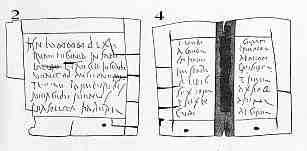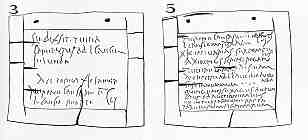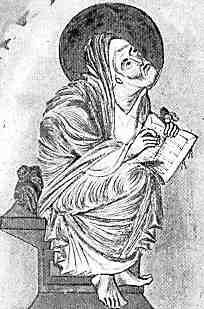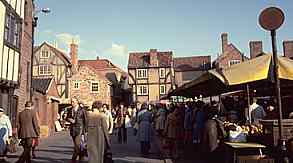




If you are looking at this page without frames, there is more information about medieval writing to be found by going to the home page (framed) or the site map (no frames).
| The Waxed Tablet | ||||
| A form of writing material which had a continuous existence from antiquity right through the middle ages was the waxed tablet. A small frame of wood was filled with wax, which could be written on with a stylus. Because the writing could be erased and the tablet re-used, they were used as notebooks for various ephemeral writing purposes. | ||||
 |
Drawings of a set of waxed tablets of AD 57, from Pompeii (Naples, Museo Nazionale). (From Steffens 1929) | |||
 |
||||
| Tablets often were laced together in sets in the form of a book. The two outer leaves had wax only on the inside, while the interior leaves were double sided. The above example from Pompeii is of a booklet of three leaves, in which the pages would be numbered as shown. Pages 1 and 6 were blank. The black dots show where they were laced together. The script of these tablets is Old Roman cursive, so we won't worry about that. | ||||
 |
While these tablets were probably used prolifically in the middle ages, they were ephemera, and as such are rarely preserved. Miniatures in manuscripts occasionally show scribes writing on what appear to be waxed tablets. In the example at left, St John is writing in something that clearly has a rectangular border with a very thin object that looks more like a stylus than a quill pen. He does not have the normal accoutrements of knife and ink pot that go with a pen. | |||
| St John the Evangelist writing on a waxed tablet in a miniature in the 9th century Evangulary of Lothaire (Bibliothèque nationale de France). | ||||
| Here a scribe is apparently writing down poetry from an oral performance, using a waxed tablet diptych and stylus, in an illustration after a miniature in the early 14th century Manesse Liederhandschrift, a book of German vernacular lyric poetry. |  |
|||
| From the miniature of Meister Gottfried von Strassburg. The original manuscript is in the Heidelberg University Library. | ||||
| A list of links to depictions of waxed tablets in art, as well as actual artifacts, can be found on the web site Waxed Tablets from Late Antiquity and the Middle Ages. | ||||
| Some very elaborate examples of tablet books have been preserved for posterity. These are carved with beautiful images in relief, with either secular courtly scenes or, less commonly, religious motifs on the outer leaves. The material may be ivory. All the examples illustrated on the web are from the 14th century. One can imagine these being swanked around in courtly gatherings, and it says something about the increasing social significance of lay literacy that the art of writing should have such posh and portable accoutrements. | ||||
| The web encyclopedia of art and architecture Insecula displays five beautifully carved tablets from the Louvre with courtly scenes. If the direct link does not work, go to the Insecula home page and type "tablettes a ecrire" in the search box. The Royal Library of Belgium displays a set of six carved ivory tablets in a leather holder and another carved ivory tablet from France. The Metropolitan Museum of Art shows an ivory tablet book carved with scenes of the Passion. | ||||
| The above examples do not retain their wax, and therefore no writing is preserved. However, in that wonderful medieval treasure city, York, a set of waxed tablets has been unearthed from an archaeological site in Back Swinegate. These are not arty carved and decorated examples, but a set in plain covers which served as somebody's practical personal notebook. Cunning conservation work has preserved the wax and the writing on it. Check out the York Archaeological Trust's own web site to find out what the man about York was scribbling about in the 14th century. | ||||
| From the York Archaeological Trust, illustrations and depictions of a find of wax tablets. | ||||
 |
The back streets of York, where you never know just what will turn up next. | |||
| Waxed tablets generally represent a stage of the writing process which has become lost to us. Ephemeral notes, preliminary drafts, notes taken by dictation and all manner of jottings may have passed through this medium before being committed to the more expensive and durable medium of parchment. | ||||
|
|
||||
|
If you are looking at this page without frames, there is more information about medieval writing to be found by going to the home page (framed) or the site map (no frames). |
||||